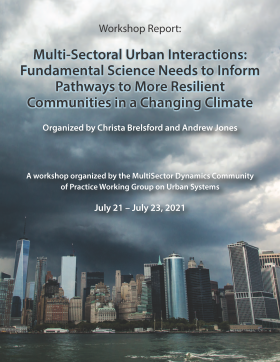Multi-Sectoral Urban Interactions: Fundamental Science Needs to Inform Pathways to More Resilient Communities in a Changing Climate
Urban areas and the supply networks that support their resource use are inherently Multi Sectoral systems composed of infrastructural, environmental, and socio-institutional components. These systems are vulnerable to accelerating and interacting stresses from climate change, population growth, resource scarcity, and land-use pressure at the same time as they have a major influence on regional and global systems. For instance, a majority of the world’s greenhouse gas emissions, food consumption, and economic activity can be attributed to urban areas. Urban areas are highly heterogeneous, both across and within cities in terms of their socio-demographic, environmental, and infrastructural characteristics. This heterogeneity shapes how urban systems interact and co-evolve and contribute to different economic, environmental, and health outcomes for communities within urban areas. Urban heterogeneity also generates differential vulnerabilities to stressors and differential capacity for adapting to change. The evolution of urban space is thus critical in shaping how human societies respond to global change as they seek to improve resilience to stressors, support prosperous and equitable communities, and use natural resources in a sustainable manner. Developing a fundamental scientific understanding of urban heterogeneity and system interactions across sectors and scales is critical for mapping the resilience, sustainability, and equity implications of alternative future pathways.
Meanwhile, there is increasing recognition that urban systems are a key context for examining fundamental questions related to system dependencies, tipping points, and uncertainties. There is also a recognition that urban areas are a fruitful context to explore methodologies for model coupling across sectors and scales. Likewise, within the federal agencies such as the Department of Energy (DOE), there is increasing interest in developing shared modeling and data capabilities for understanding water- and energy-related challenges, many of which intersect with urban infrastructural, environmental, and social systems. However, efforts to coordinate among research groups and combine multi sector urban tools and insights to examine key uncertainties, interactions, and trade-offs are still nascent.
While social, ecological, and engineering domain-centered research is critically important, this siloing has the potential to lead to incomplete solutions or unintended tradeoffs. Making one part of an interconnected system more robust can introduce vulnerabilities elsewhere. Solutions that address only one system domain are unlikely to prove resilient in the future, under new and different stressors across these system domains.

